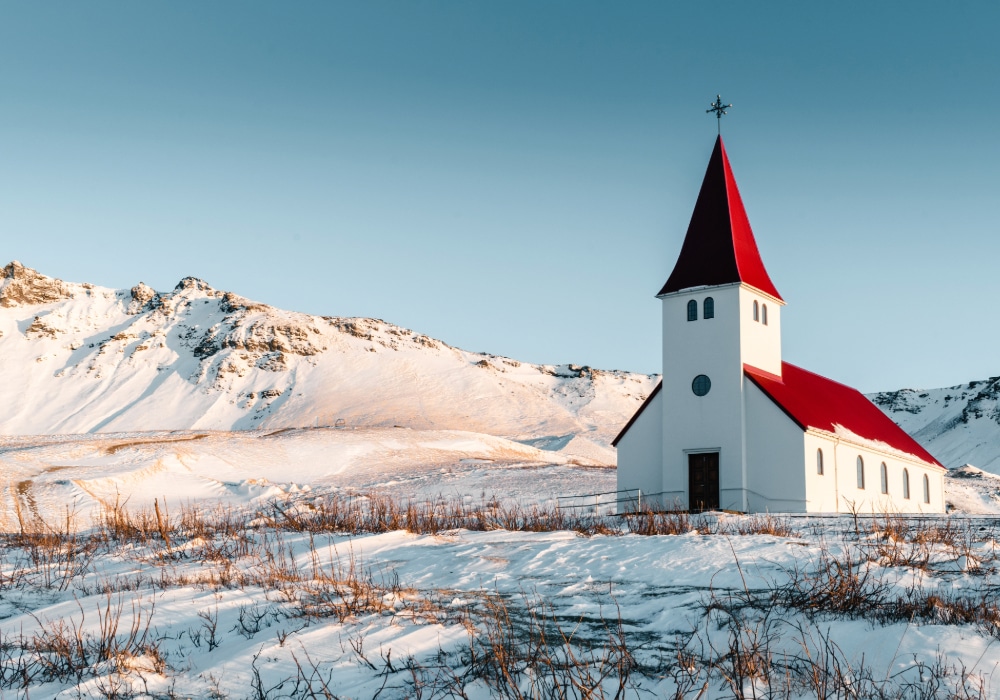
10 practical tips to discover Iceland on a budget in winter [2024]
Embarking on a winter adventure to Iceland doesn’t have to drain your bank account. In fact, with a bit of savvy planning and some insider tips, you can experience the magic of this Nordic wonderland without breaking the bank. From chasing the Northern Lights to soaking in geothermal hot springs, Iceland offers so many unique winter experiences for budget-conscious travellers. So, grab your warmest layers and get ready to discover Iceland on a budget with our 10 practical tips!
WHY IS ICELAND SO EXPENSIVE?
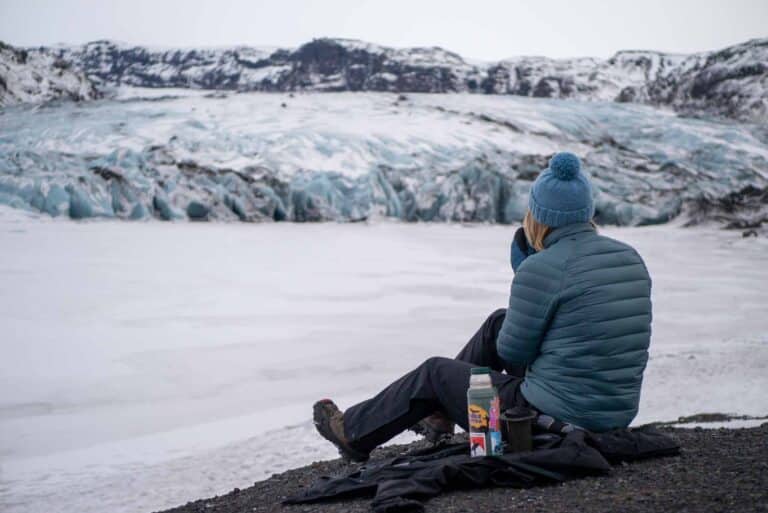
Visiting Sólheimajökull Glacier for a walk and coffee. Bring your own flask and just pay for parking!
10 TIPS FOR EXPLORING ICELAND ON A BUDGET
#1 GO IN WINTER
If you want to visit Iceland on a budget, go in winter. Winter is considered the off-peak season in Iceland. Yes, everything slows down a little, and lots of accommodation, activities, and restaurants close for the season. But there are unique adventures only to be found in winter, such as glacier hiking, ice caving, and chasing the elusive Northern Lights.
In winter, you’ll find lower prices for accommodation and tours compared to the summer months. Some accommodation can be half the price or less. We found prices on a par with hotels and self-catering flats here in Scotland. Accommodation wasn’t ‘budget’, but it was much cheaper than we were expecting from such a notoriously expensive country!
I can highly recommend visiting Iceland in late winter (February or March). You’ll get to enjoy longer days and slightly milder weather without compromising on accommodation and tour discounts. We visited Iceland in early February. The sunsets were gorgeous and the pink skies lasted for hours. The the days were just about long enough to pack in everything we wanted to do. And the weather was perfect – crisp, cold and clear. .
#2 BRING YOUR OWN FOOD
Dining out in Iceland is expensive. We only did it once during the week we were there! If you can, cooking your meals in self-catering accommodation instead of eating out will help you to visit Iceland on a budget. Self-catering can also be especially convenient during the winter when lots of restaurants are closed for the season.
Travellers can import up to 10 kilograms of food to Iceland. So, do a little meal planning before you go, and stock up on things like pasta, lentils, spice mixes and tinned produce. Don’t forget to pack cereal bars, trail mix, and sweet treats of your choice to snack on during the day! And remember, you can’t import meat and dairy products from outside the European Economic Area.
Of course, it’s important to support the economy of every country you visit. You can pick up fresh produce, such as milk, yoghurt, cheese and fruits and vegetables in Iceland once you arrive. This means that you can use your tourist money to enjoy unique Icelandic products (charcoal pizza or salted liquorice anyone?). It’ll likely be expensive compared to your home country, but not as expensive as doing a full shop.
If you hate cooking, we recommend that you research your restaurants in advance. This way, you can pick ones you know you want to go to. There’s nothing worse than paying good money for average food. For us, this was Black Crust Pizzeria in Vìk (hands down one of the best pizzas of my life). If you choose to eat out, it’s worth paying the little extra for higher-end food. It won’t be much more expensive but the quality will be significantly better!
You can also eat during happy hour for a small discount. If you want something on the go, Icelandic hot dogs (Pylsur) are everywhere. If there’s a queue in Reykjavik, it’s usually for a hot dog stand.
Travel hack: if you need to eat before getting to the airport, there’s an IKEA halfway between Reykjavik and Keflavik, and it’s cheap. Can’t go wrong with IKEA’s plant-balls with gravy and mashed potato in any country!
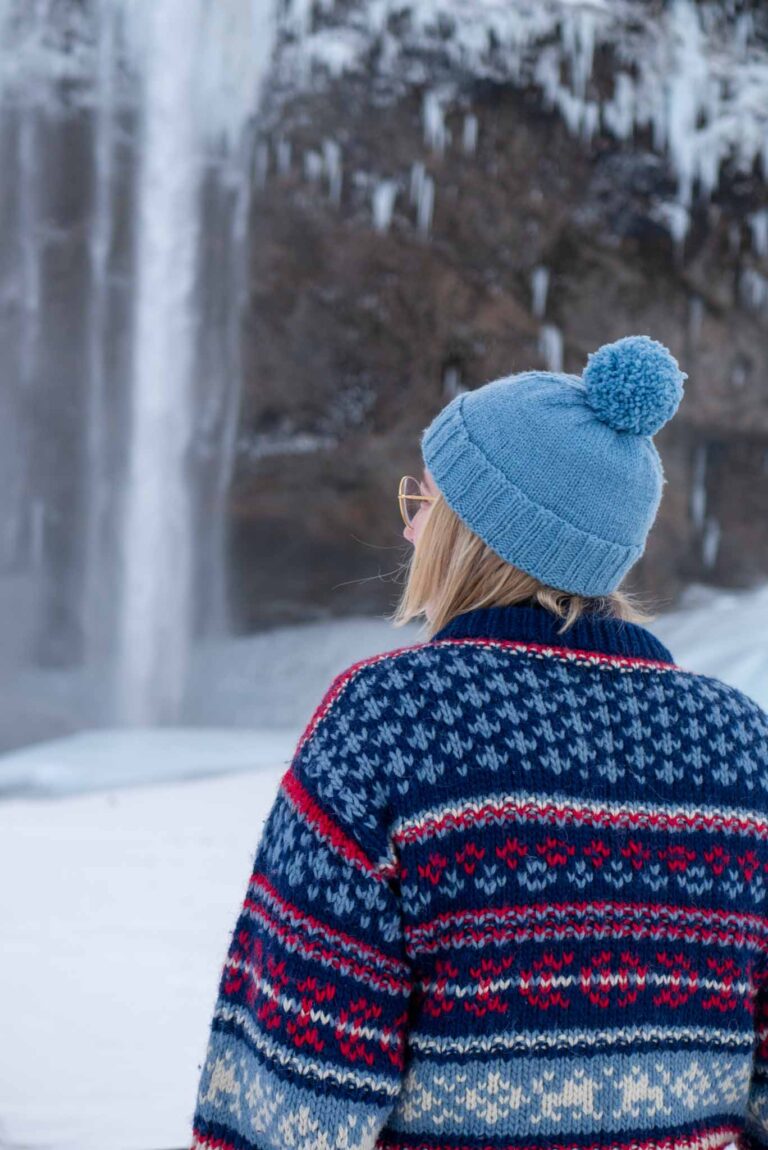
Exploring Seljalandsfoss Waterfall before… you guessed it… stopping to make a coffee
#3 SHOP IN BUDGET SUPERMARKETS
Unless you’re from the EEA, you won’t be able to bring fresh produce into Iceland with you. If you’re planning a trip to Iceland on a budget, you may want to stock up on fruit and vegetables in the supermarket. You might also want to buy meat and dairy if those are things that you eat. But, it’s important to pick your supermarket wisely. Some are more expensive than others.
Never be enticed by the luminous green sign of a 10-11, it’s the most expensive grocery store in Iceland. Shopping there will add at least 50% to your grocery bill compared to the budget stores like Nettó, Bónus, and Krónan. It’s definitely worth going out of your way to find one of these cheaper stores. You’ll save a lot of money!
#4 OH, AND YOU CAN DRINK THE TAP WATER
Icelandic folk are fiercely proud of their tap water. It’s fresh, it’s clean, it’s good. Most of it comes straight from the glaciers. There’s absolutely no need to buy bottled water in Iceland. It’s just wasted money – no good if you’re on a budget trip to Iceland!
You’ve got no reason to worry about getting sick from the tap water in Iceland. But if you’re concerned, we recommend travelling with a Water to Go filter bottle. This travel filter water bottle is one piece of travel kit that we don’t leave home without. It lets you fill up from any freshwater source (even rivers and murky lakes) and removes 99.9999% of all microbiological contaminants – that’s bacteria, viruses, heavy metals etc. You’ll also massively cut down on your plastic waste too!
Feel like saving money and saving the planet? Check out our review here, or head straight to the site with this link for your 15% discount!
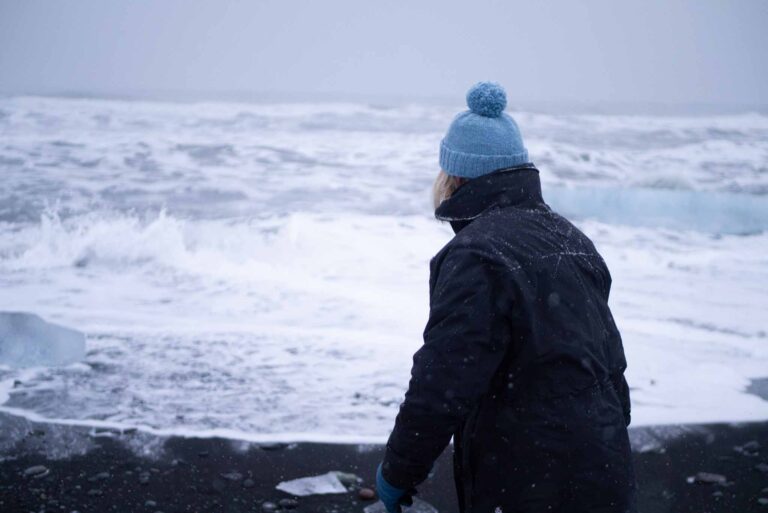
Diamond beach, free to explore, just pay for parking!
#5 IF YOU WANT TO DRINK ALCOHOL, GRAB IT BEFORE YOU LEAVE THE AIRPORT
Alcohol is very expensive in Iceland. This is because it’s so heavily taxed. For example, 80% of the price of a bottle of vodka, gin, or other spirits is just tax! The prices of alcoholic beverages in bars and restaurants across the country reflect this. If you do drink alcohol, you might be wondering how you can enjoy Iceland’s craft beers and small-batch spirits without breaking the bank.
If you’re visiting Iceland on a budget, we recommend buying alcohol at Keflavik International Airpot! There’s a duty free shop just before you go through baggage reclaim and customs. if you enjoy a drink on your vacation, you might want to think about grabbing your tipple of choice before you enter the country. Everyone entering Iceland is entitled to import six units of alcohol. Units are different in every country. Six units in Iceland would add up to, for example, one bottle of spirits, one bottle of wine and a six-pack of beer. You can calculate it here.
Top tip: when you’re heading back home after your adventures, be sure to check out the airport shops. Keflavik International Airport is one of the only airports in the world that is tax-free and duty-free. This means that you can pick up some cheap souvenirs to take home.
#6 HIRE YOUR OWN CAR…
Public transport is expensive in Iceland, and taxis cost even more! If you’re looking to adventure anywhere outside of Reykjavik and the Golden Circle, you’ll need to hire a vehicle. If you’re travelling in a pair or group, this will be cheaper than taking daily tours. In addition to saving money, you’ll also be in charge of your itinerary. I hate being told what to do and where to go, so this was perfect for us!
If your car hire company offers the option, we recommend you choose an ‘old model’ of car. The road conditions in Iceland aren’t always the best. It’s very easy for your car to get small scrapes and scratches, even if you treat it right. Our rental car got a tiny chip in the window from an overenthusiastic tour bus driving too fast. If you hire an older model, you’ll save a little money. Plus, the car hire company will be less likely to notice if you add one new scuff to the ten already on there.
But, don’t underestimate the price of fuel! As with everything in Iceland, fuel is also expensive. This is especially important in winter when road conditions will necessitate four-wheel drive and winter tyres. With icy road conditions, our car was guzzling fuel. We spent on average £40 ($50 USD) a day on fuel alone, which I did not plan for!
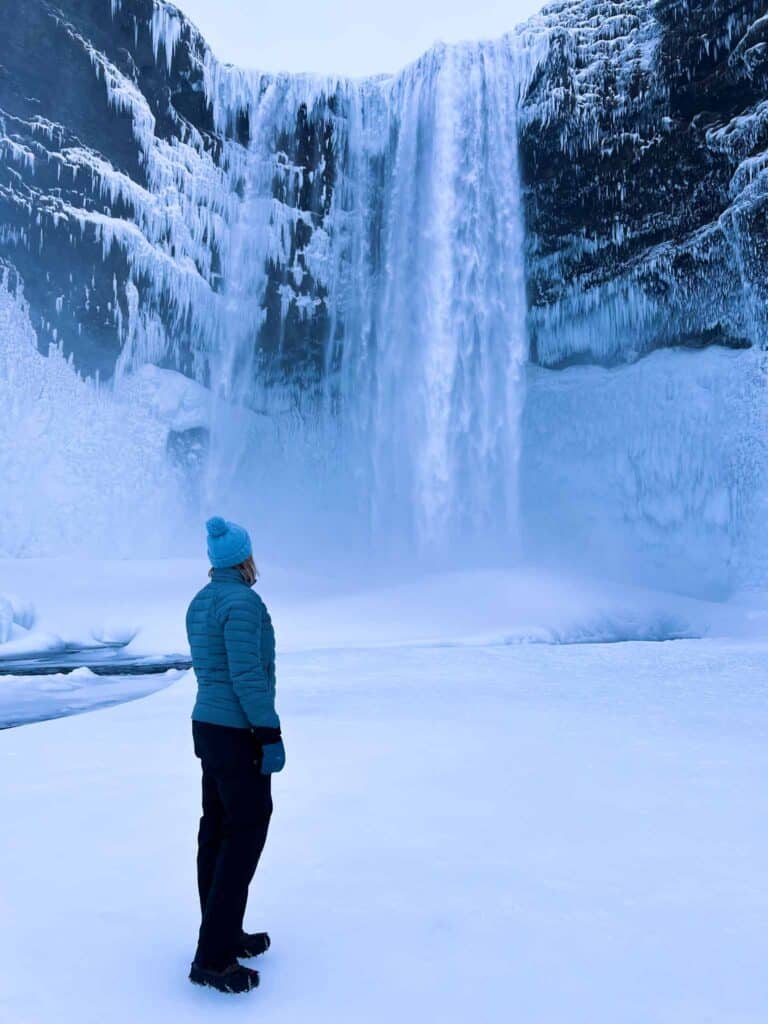
Hiring your own car means that you can enjoy popular sites without the crowds
#7 … BUT NEVER BUY FUEL ON THE HIGHWAY
As with many things in Iceland, fuel is imported, and therefore expensive. This means that it’s so important to fuel your tank at the right gas station if you’re visiting Iceland on a budget
The cheapest place to fuel up is Costco. However, you won’t really find one of those outside of Reykjavik, and you have to be a Costco member. Orkan gas stations are also a good shout. We noticed that they were consistently cheaper than the competitors.
We didn’t realise this until the end of our trip, but it’s m ore expensive to buy fuel on the highway (or Route 1). Fuel stations along the main roads hike up the prices by ~30 Króna (£0.17 | $0.20 USD) per litre. And that adds up! Driving off the highway into a small town will help to keep your fuel costs low.
#8 SKIP THE NORTHERN LIGHTS TOURS
Iceland has so many unique experiences on offer but organised adventures and tours can be expensive. You should definitely try some of the cool activities in Iceland if you can afford it. But we recommend that you save your money for an experience that you literally can’t have without a guide.
This means (and hear me out here) that you might want to consider skipping the Northern Lights Tours if you’re visiting Iceland on a budget
The polar lights are a natural phenomenon, and there’s never a guarantee that you’ll see them. On a Northern Lights Tour, all they do is pop everyone in a minibus and drive you out of Reykjavik. This gets you away from the light pollution of the city to an area with low cloud cover. Then, the tour guide hands out hot chocolate, crosses their fingers and hopes that the Aurora Borealis puts on a show.
Having a guide can be useful for pointing out what to look for (no surprise, but lots of Northern Lights photos are heavily edited!). They can also help with tips for taking good photographs. But booking a Northern Lights Tour doesn’t increase your chances of seeing them. Like most things in nature, the aurora is unpredictable.
If you’re hiring a car anyway, you can save a significant amount of money with a ‘DIY Northern Lights Tour’. Check the weather and cloud cover yourself on the official Iceland Meteorological Office website. Download a couple of apps to alert you to when your chances are high. Then follow our guide; wrap up warm and drive somewhere north facing with clear skies and higher altitudes. If you’re interested in photography, you can check out some photography tips before you go. Usually this involves using long exposure, which you can do with your smartphone!
Or, if you’re wanting to relax, consider booking a cottage with a hot tub. Best case is that you’ll see the Aurora, worst case will be a beautiful starry sky.

At 1/4 of the price, Secret Lagoon is a great alternative to Blue Lagoon for travellers on a budget
#9 CHOOSE THE RIGHT HOT SPRING EXPERIENCE
The Blue Lagoon is beautiful. But despite popular perceptions, it’s not a ‘real’ natural pool, instead being heated by a geothermal power plant. And with its proximity to Reykjavik and Keflavik International Airport, we think that, honestly, it’s a bit of a tourist trap. Even in a country as expensive as Iceland, it is scandalously pricey, with most slots costing ~£80 / $100 USD. Yes, this includes a beer and a face mask, but even so…
The good news is that an outdoor heated pool is to Icelanders what a pub is to the British and a café is to the French. It is a place to meet with friends, catch up, and pass time together.
If you want to enjoy a natural hot pool, there are so many cheaper and better options, We visited the Secret Lagoon (£20/$25 USD) on our DIY Golden Circle itinerary. It was blissfully warm, heated by mini geysers and surrounded by moss-covered stones. Soaking up the sunset at Secret Lagoon was one of the highlights of our trip.
For a more ‘polished’ experience, you could also check out Sky Lagoon (£40/$50 USD). This upmarket hot spring has a natural infinity pool and you can upgrade to enjoy spa facilities. For something more natural, look out for Hrunalaug (£12/$15 USD). This small, hidden hot spring pool in Flúðir is surrounded by grassy slopes and mountains and only has enough room for a small group. The Reykjadalur Hot Springs River is an excellent free hot spring. You’ll have to earn your swim by hiking to it, but soaking here was absolute bliss in winter. You can check out our guide to the winter Reykjadalur Hot Springs hike here.
#10 ENJOY FREE WINTER ACTIVITIES
Contrary to popular belief, not everything in Iceland costs money! If you’re visiting on a budget, you can definitely take advantage of free winter activities
If you’re staying in Reykjavik, why not join a free walking tour? This is a great way to get your bearings in a new city. You are expected to tip your guide at the end, but you can give as much as you can afford. Reykjavik also has many winter markets and festivals to get the Icelanders through the dark months. We loved the Winter Lights Festival, where everything is lit up, open late, and there are tons of free events to celebrate the near-end of winter.
Almost all of the famous natural attractions are accessible year-round and can be enjoyed on a limited budget. This includes Þingvellir National Park, Geysir Geothermal Area and Skógafoss, Seljalandsfoss, and Gulfoss waterfalls You may pay a small fee for parking (usually £5-6 / $8-9 USD). But you can make the most of this by planning a short hike or picnic at these sites.
Many of Iceland’s popular short hikes are beautiful in the winter. They offer an easy way to get away from the crowds. Most hikes are accessible, as long as you’ve got suitable hiking boots and small crampons/microspikes like these, which you can buy at most outdoor shops or hike in Reykjavik. Remember to check the weather forecast and never hike outside your capabilities!
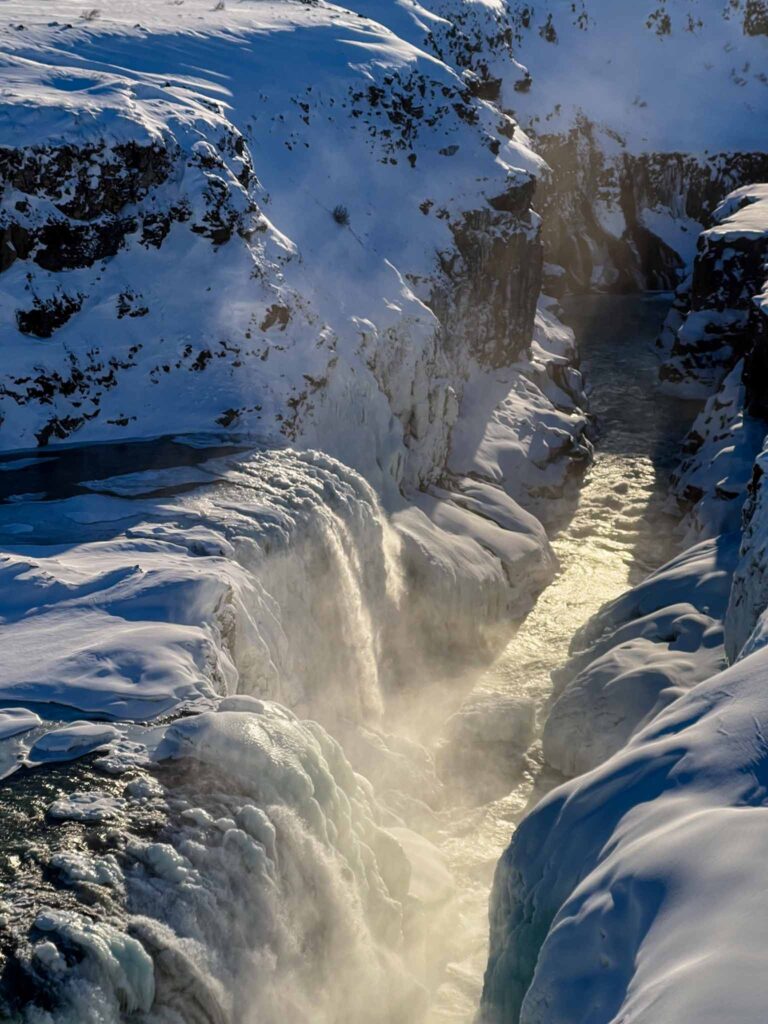
Gulfoss Waterfall: entry and parking are completely free!
FINAL THOUGHTS
In conclusion, exploring Iceland on a budget is entirely feasible, especially during the winter months when off-peak deals are plenty. You just have to decide where it’s worth spending money, and where you can cut back!
We knew that we wanted to dive between tectonic plates in Þingvellir National Park. We also knew that we wanted to explore the ice caves of the Vatnajökull Glacier. Neither of these were budget-friendly activities. But we were able to compromise by cooking our own food and staying in cheaper accommodation (no hot tub for us!). We also enjoyed free activities, such as hiking and visiting Iceland’s popular natural attractions.
By following our practical tips, such as traveling in late winter, cooking your own meals, and being selective about the activities you do, you can enjoy all that Iceland has to offer without breaking the bank. So, pack your sense of adventure and get ready for an unforgettable Icelandic experience without the hefty price tag!
LIKE IT? PIN IT!
SAVE THIS POST TO YOUR PINTEREST BOARD TO COME BACK LATER


Follow our daily adventures on Facebook and Instagram
Disclaimer: The information and advice provided in this blog are the author’s opinions and based on their personal experiences. All information was accurate at the time of writing. However, things can change quickly, so always double-check current conditions and guidelines before setting out. Remember, your travels and safety are your own responsibility, and this blog can not be held responsible for anything that might happen on your adventures! Always exercise caution and good judgment. Oh, and don’t forget to get travel insurance! Happy travels!
This post may contain affiliate links (yay for transparency!) This means that I will earn a small commission, at no additional cost to you, if you click the link and choose to buy the product. I only link to stuff I have personally bought and found useful and never endorse crap. Your support helps keep the site going, thank you!
Alice
Alice is a UK travel blogger who advocates sustainable travel and being more eco-conscious on a budget. She loves coffee, her houseplants and summiting mountains.
You May Also Like
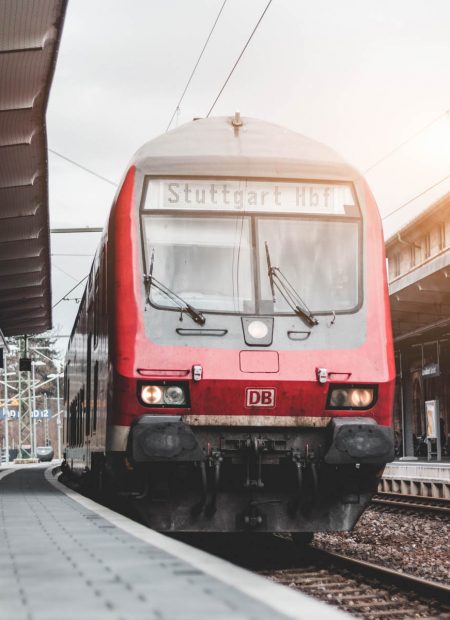
Europe’s Sleeper Trains: Have they run out of steam?
November 28, 2020
The Green Guide to Luxembourg
July 11, 2020